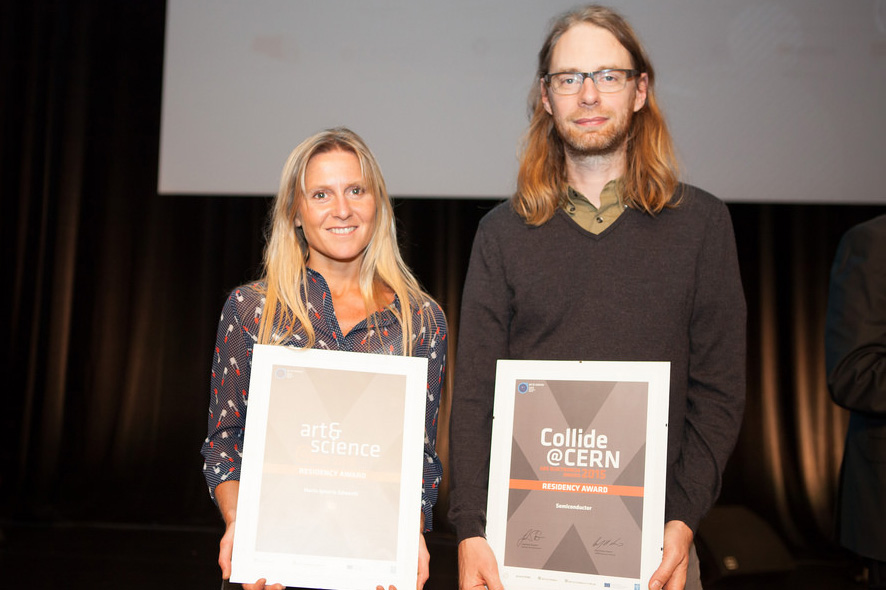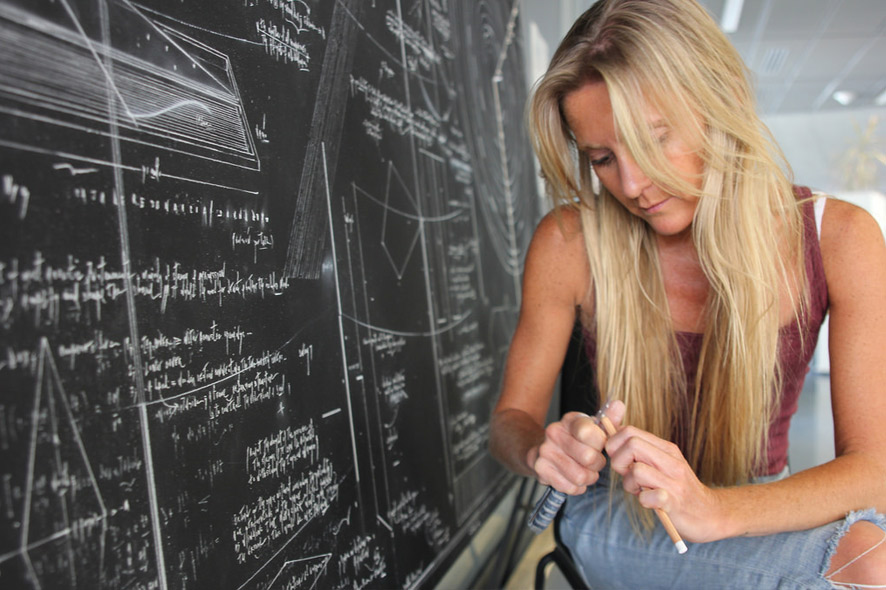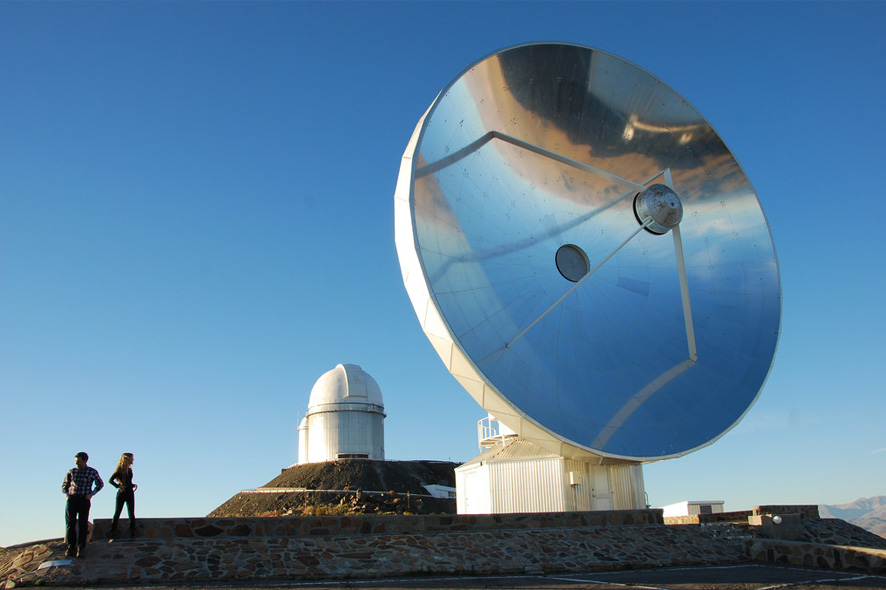In cooperation with the ESO in Chile, Ars Electronica is offering interested artists the next window of opportunity for a stay of several weeks duration at one of the ESO’s facilities in Chile and at the Ars Electronica Futurelab in Linz. The deadline of the open call for applications is November 29, 2015. ars.electronica.art/artandscience is the go-to website for further details and to submit a description of the art project you currently envision. But how does a residency like this actually work? In fact, there’s a single precedent: last year’s recipient. María Ignacia Edwards was the first artist to be granted this privilege by the European Art and Science Network. We recently discussed this unique program with Claudia Schnugg, the Futurelab staffer responsible for oversight and development of the Ars Electronica Residency Network.

Photo: Claudia Schnugg
Only a few weeks after the jury selected María Ignacia Edwards as the residency recipient, you accompanied her on a tour of the ESO’s various sites in Chile. What did you do there?
Claudia Schnugg: Basically, we begin a residency by escorting the artist on an introductory visit to the scientific partner—in this case, the ESO—in order to establish contacts, launch the process of encounter with the physical locations and the people there, initiate dialogs and reveal inherent potential. In this case, the point was to accompany María Edwards on a fact-finding tour of all three observatories that came into consideration as potential locations for her residency, since she didn’t initially stipulate a specific ESO facility on the basis of the particular technology available at it.
The itinerary of this quickie excursion included several very remote locations in Chile. Our first stop was Paranal, where we were briefed on the VLT, an optical telescope that’s one-of-a-kind at present, and VISTA, and we had a chance to experience the extraordinary isolation of this physical setting. Then it was on to La Silla, a place that’s similarly remote but somewhat less hostile to life, and features structures with a totally different orientation. In the ultramodern facility in Cerro Paranal, there’s a strong focus on the VLT and visitors can sense the concentration on data production, whereas in La Silla, you’re able to get a feel for the human level and experience this outpost’s 50-year history. The outstanding features here are the numerous smaller telescopes that have been installed and used over the years. La Silla offers a comprehensive picture of the technology’s historical development—for example, the control rooms that used to have to be built directly adjacent to the telescopes but are now further removed thanks to improved remote control.

Photo: Claudia Schnugg
Our final stop was ALMA, a stark contrast to the other locations both with respect to the technology and the landscape. This is ESO’s center for sub-millimeter telescopy so it’s less remote and not far from San Pedro de Atacama and other small towns. ALMA’s setup is also far different, considering the huge distance between the Operation Support Facility, where the control rooms, living quarters, visitors center and antenna maintenance workshops are located, and the High Site at approximately 5,000 meters above sea level where the antennas are positioned and where, for safety reasons, even people who are physically fit are permitted to spend only two hours at a time.
Were you permitted to, so to speak, look through the telescope?
Claudia Schnugg: Basically, all of the ESO’s locations that can be visited in conjunction with the residency are scientific facilities. That is to say, they’re not universities where, throughout the year, scientists are working on projects, evaluating data, or even immediately generating images from them; instead, they’re places to which scientists are granted access to various telescopes and instruments for short periods of time to permit them to speedily gather as much data as possible. When the ESO authorizes a scientific project, its staff is assigned a telescope for a fixed time span. Plus, in the case of ALMA, there are other decision makers involved, since the facility isn’t operated solely by the ESO; other institutions, the U.S. National Science Foundation and the National Institutes of Natural Sciences of Japan, are also involved.
Thus, the scientists don’t have much time for encounters with artists, and many of them aren’t even on site throughout the entire residency. You have to keep in mind that they sleep during the day and spend the entire night in the control room in order to gather as much data as possible in this brief period of time. The scientists then take their data with them back to their respective home institutions for processing and analysis. This is the scientific process that then gives rise to images, discoveries and theories. This is why we’ve been considering offering certain artists the opportunity to also visit the ESO’s headquarters in Garching in the vicinity of Munich. But, basically speaking, the focus of this ESO Residency is on the observatories, the technology, the various approaches to research, and on the locations themselves.
María Ignacia Edwards selected La Silla and a short outing to ALMA for her residency, which she did in June. In August, she spent several weeks at the Ars Electronica Futurelab in Linz. What did she do there?
Claudia Schnugg: The communication with María began immediately after the jury reached its decision. I was in contact with her right from the outset, discussed the project with her, the various possibilities and what she was interested in. The outcome of this dialog went into custom-planning her introductory visit, and also brought out initial directions and ideas for her project. Following her residency at the observatories in Chile, she developed her project further here at the Ars Electronica Futurelab. The process of working together with her was very intensive. We discussed many substantive issues, developed the work together with our hardware & software experts, and even provided artisanal help in the project’s implementation.

Photo: Magdalena Leitner
The project was then a part of the “Elements of Art and Science” exhibition that premiered at the 2015 Ars Electronica Festival.
Claudia Schnugg: Exactly. For the artist, those were very intensive days in early September 2015 at the Ars Electronica Festival, where she attended the awards ceremony and also participated in public discussions in conjunction with the Prix Forum. Now, her work is the centerpiece of the “Elements of Art and Science” exhibition at the Ars Electronica Center Linz, where it will be on display for some time to come. María Ignacia Edwards conceived her work in such a way that the main portion will remain in Linz and other parts can be presented at the other European Art and Science Network member institutions. Since October 8, 2015, a part of her work has been on exhibit at the Media Art Biennale in Santiago. Beginning in November, she’ll present her artwork at LABoral in Spain. And the next run after that is in Zaragoza.

Photo: Tom Mesic
When you look back at the 1st Art & Science Residency, would you conclude that everything went off as planned?
Claudia Schnugg: What we’re attempting to do in these residencies is to provide artists with entrée into scientific fields. I was extremely pleased with how this turned out with María, the way this process became visible in the development of her work. In her initial proposal, she precisely defined how and in which direction she aimed to go and what she expected from the respective ESO locations. Nevertheless, she ended up developing the work she completed during the residency in a totally different direction as a result of her encounters with scientists and the Ars Electronica Futurelab staff. At each step of the way, you could see the changes the project had gone through and where the inputs had come from.

Photo: Magdalena Leitner
What advice would you give to artists who are now responding to the open call to select the next recipient of a residency at the ESO in Chile and at the Ars Electronica Futurelab?
Claudia Schnugg: For one thing, I strongly recommend perusing the ESO’s homepage. Many of the artists who responded to the first open call simply wanted to obtain astronomical images, which are conveniently available right on the ESO website and thus without traveling to South America. They ought to get an idea of what the European Southern Observatory is all about—for instance, which technologies are used and why the physical locations are interesting. And to avoid confusing the ESO with other institutions such as the ESA or NASA. Potential applicants should ask themselves: What would I like to do there? What does my further development as an artist call for? What can I as an artist bring to this project? Why is visiting these ESO locations essential for my project?
Have we aroused your interest? Are you ready to submit a project you’d like to realize during a residency at the ESO? This open call runs until November 29, 2015. Complete details are available at ars.electronica.art/artandscience. We have collected further impressions of María Ignacia Edwards stay in Chile on ars.electronica.art/feature.
